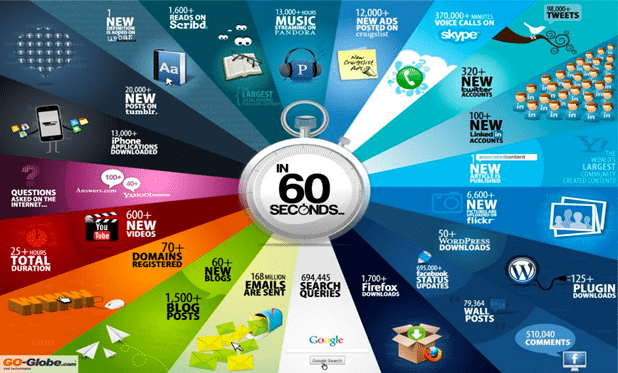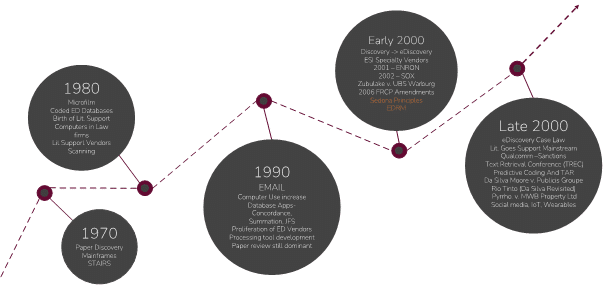From Bankers’ Boxes to Hard Drives- the Evolution of eDiscovery
Since the introduction of the “E” to eDiscovery, there has been a massive transformation in where and how lawyers and legal professionals look for Electronically Stored Information (ESI).
The eDiscovery process, once rife with banker boxes full of email, expanded dramatically with the advent of the internet, and the velocity in the development of innumerable data types, sizes, and formats has not stopped.
At the inception of consumer-grade internet, it took minutes to even connect to the internet, and most of us old enough to recall at least the mid-90s still hear the crackling sound of a modem connecting.

Now, in a single minute, over 400,000 apps are downloaded, 20 million texts sent, 100’s of millions of emails are sent and over 750,000 hours (about 85 and a half years) of Netflix are binge-watched. This volume of creation and consumption has grown dramatically just in the last few years. Netflix’s number of hours watched in a single minute grew by 1000% from 69,444 in 2016 to 764,000 in 2020.
So, what is a digital detective to do? Where should law firms, in-house, and legal service providers look to uncover potentially relevant electronic information?
How Did eDiscovery Get Started?
Ah, the history of eDiscovery – a tale as old as time (or at least as old as the digital age). Once upon a time, in a land not so far away, legal professionals were forced to sift through mountains of paper documents to build their cases. It was a grueling process that required highlighters, paperclips, and the patience of a saint. But then, in the late 1990s, along came the digital age, and everything changed.
As people started to communicate increasingly through email, text messages, and other digital channels, legal professionals realized that electronic data could be a goldmine of evidence in legal cases. However, they also quickly realized that they needed a new set of tools and techniques to deal with this digital evidence.
In addition, the court realized that electronic documents and electronically stored Information (ESI) were relevant in many cases and amended the Federal Rules of Civil Procedure (FRCP) in 2006. Adding Electronically Stored Information (ESI) to the discovery obligation. And so, eDiscovery was born.

From Email to Ephemeral Data, oh my!
I the beginning of eDiscovery, the scope of Discovery requests only extended to electronic documents like Word documents, excel spreadsheets, and PowerPoint presentations as well as the increasingly ubiquitous email. But as the ways humans communicate electronically increased so did the potential sources of ESI for each custodian.
Today a legal hold may extend far beyond just email and electronic documents to include short-format messaging, social media, Instant messages and even self-destructing (ephemeral) messaging, text, and more. In the quest for relevant information, legal teams and case law are fighting a never-ending battle to keep up with the speed of digital innovation.
Data sets are now comprised of a massive volume and variety of ESI sources. And document review is often reliant on AI-powered technology to cull down the increasingly vast data sets in civil litigation. AI-powered workflows like Technology-assisted review (TAR)are increasingly common because of the data explosion facing legal teams.

From Bates Stamps to AI
In the early days of eDiscovery, legal professionals were forced to use basic search and retrieval tools to find electronic evidence. But as the volume of electronic data exploded, eDiscovery tools and software evolved to keep pace. Today, we have innovative tools and techniques like predictive coding, machine learning, and artificial intelligence to help us sort through massive amounts of data and find the evidence we need.
Of course, as with any innovative technology, there have been challenges and setbacks along the way. Legal professionals have had to navigate privacy concerns, ethical considerations, and constantly evolving technology. But through it all, eDiscovery has remained a critical player in the legal world, helping legal professionals uncover digital evidence and build strong cases.
So, there you have it, the history of eDiscovery – a tale of innovation, perseverance, and a never-ending quest for relevant data.



